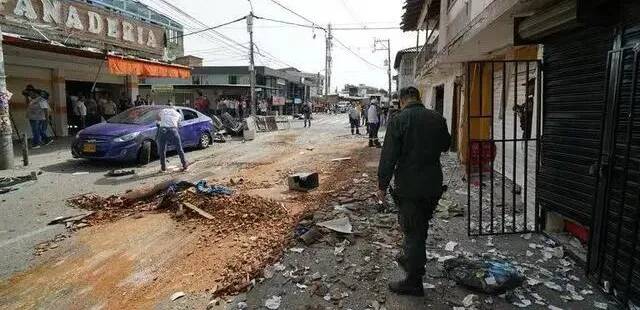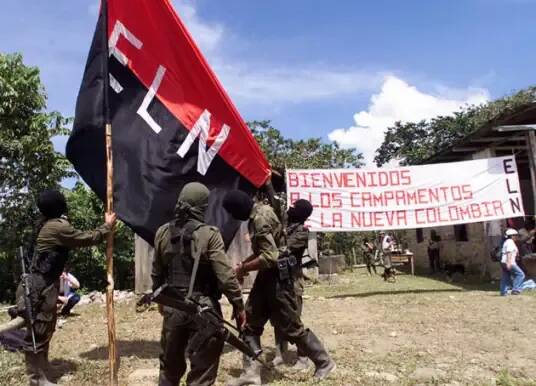The civil war in Colombia intensifies! Will face two major anti-government forces
According to Colombian local media reports, Colombian Defense Minister Ivan Velazquez announced on August 5 that military operations against the rebel National Liberation Army of Colombia (ELN) would be resumed and that the previous cease-fire agreement between the two sides would not be extended after it expired on August 3.

According to reports from the National Liberation Army of Colombia, the Colombian government violated the terms of the ceasefire agreement and asked the government to remove it from the list of organized armed groups, otherwise it could not consider extending the ceasefire.
It is understood that the "National Liberation Army of Colombia (ELN)" was founded in 1964 and now has about 4500 members. It is the second largest guerrilla organization in Colombia after the Revolutionary Armed Forces of Colombia, which has been at war with government forces since its establishment. At present, the organization is mainly active in the provinces of Choco, Cauca, Narinho, Putumayo and Northeastern Santander in southwestern Colombia.

At present, Colombian President Gustavo Petro has been actively promoting peace talks between the government and the Armed Forces for the Liberation of Colombia since he took office in August 2022, but recently, the peace talks between the two sides have stalled again. And the armed group threatened to resume kidnapping, robbery and other operations to obtain funds if the problem of providing funds to the armed forces could not be solved.
At present, the ongoing internal conflict in Colombia is due to the fact that in July, the Colombian Defense Minister announced the termination of the ceasefire agreement signed with some factions of the rebel group Central staff. In addition, all-out offensive operations against the faction of the "Central staff headquarters" have been issued to the army. The Central staff is an offshoot of the former Revolutionary Armed Forces of Colombia (FARC), Colombia's largest rebel force. As a result, Colombian government forces are currently facing the two largest rebels in the country.
Moreover, at present, the two major rebels are mainly active in the provinces of Choco, Cauca, Narinho, Putumayo and Northeastern North Santander in southwestern Colombia. And recently, local media also reported that a number of abusive incidents such as kidnappings occurred in rural areas of these provinces.
If government forces carry out offensive activities against the rebels in these areas, it will have a serious impact on a number of industries in the region, especially agriculture, one of the country's pillar industries. Among them, Cauca, Narinho and North Santander are all one of the important coffee producing areas in Colombia, with many well-known coffee estates and some small coffee farmers. The civil war conflict will lead to the displacement of civilians, and the destruction of roads and other infrastructure in the area will eventually affect the quality and output of coffee in these areas.
Moreover, in this province, there is also the location of Colombia's main port, and coffee is also one of the main sources of foreign exchange earnings, and these rebel groups may earn foreign exchange by robbing coffee beans in order to buy arms. Eventually affect coffee exports.
Earlier, the price of Arabica coffee fell, but recently, the Brazilian climate department showed that the temperature in some coffee producing areas in Brazil is expected to drop to close to 5 ℃, which will adversely affect coffee production and trigger radical behavior in the market, leading to a rebound in coffee prices. At present, the decline in coffee production caused by the civil war in Colombia, the third-largest coffee producer, will further push up coffee prices.
Important Notice :
前街咖啡 FrontStreet Coffee has moved to new addredd:
FrontStreet Coffee Address: 315,Donghua East Road,GuangZhou
Tel:020 38364473
- Prev

Nanny-level detailed tutorial on ice hand-chaining: How does golden Mantelin coffee break out of its lingering charm?
On a sunny afternoon, after leaving the air conditioner, it was a 40°C high-temperature "stewing". The dazzling light began to slow down everyone's work efficiency. Qianjie, who was typing on the keyboard, also fell into a state of food deprivation. It seems that it's time to get a glass of cold Mantenin to refresh your spirits. Front Street started off with ice on deep-roasted coffee
- Next

What are the characteristics of the Obaraca coffee region in Honduras? What famous manor is there?
Central America is rich in natural resources, with a terrain dominated by plateaus, mountains and forests. It has a volcanic belt of more than 1300 kilometers long. Volcanic ash deposits and fertile soil. Coupled with the diverse climate here, Central America coffee has an important role in the global coffee market. Status, it has many well-known coffee-producing countries, such as Hondura
Related
- Why can American refills for free? The difference between Americano and American drip pot coffee
- Being chased out of the rain in front of Starbucks?! Store: Sheltering from rain under umbrellas poses a safety hazard
- The white moonlight has changed?! Lucky launches "Big Winter Pear American"
- Hand-brewed coffee three-stage method, high-sweet and universal brewing method to share! What does the high sweet water level of hand-brewed coffee mean?
- What is the difference between raw, refined and full espresso coffee? How to extract espresso and taste good?
- A complete list of coffee bean names and their meanings! What is Yejia Shefi coffee? Where is Mantelin coffee?
- What grade does Arida Manor Kaduai coffee beans belong to? What treatment is Arida ASD slow anaerobic sun exposure?
- The milk tea cup becomes smaller?! Overlord Tea Girl launches a new "Return to Yunnan" series
- Accused of selling counterfeit and high-priced coffee beans! Well-known boutique coffee brand "Oukelao" bowed and apologized!
- How to make espresso dumplings? Can I eat coffee and glutinous rice balls together?

